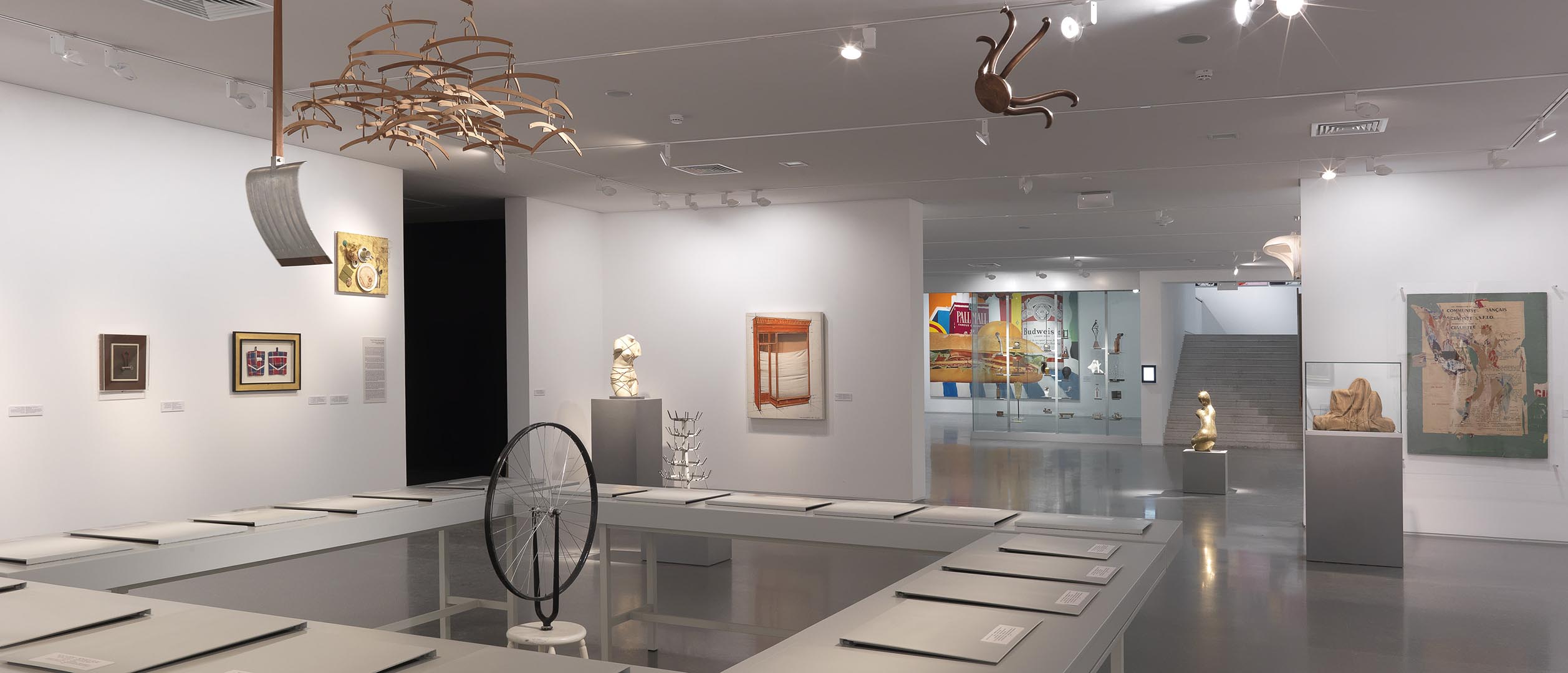
Dada and Surrealism
Dada, Surrealism and their Legacies in the Israel Museum
The Vera and Arturo Schwarz Collection of Dada and Surrealist Art
Dada and Surrealism rank among the most significant movements of our time. They challenged tradition, introducing materials and visual strategies that would change the vocabulary of art and creating an enduring legacy that has transformed art history.
The connection between Surrealism and the Israel Museum began as a “chance encounter” more than fifty years ago, and it has since evolved into a deep and lasting relationship. Thanks in great part to generous gifts from donors and artists alike, the Museum has been able to form a spectacular holding of Dada and Surrealist material, comprising everything from paintings, readymades, and photographs to works in the wide variety of new and innovative mediums employed by these groundbreaking movements.
This repository also includes an extensive library and documentary materials that make the collection an important international research resource.
The Museum owes this richness first and foremost to Arturo Schwarz, who in 1972 gifted thirteen replicas of readymades by Marcel Duchamp, followed in 1991 by his gift of the Arturo Schwarz Dada and Surrealist Library, a rare accumulation of documents, periodicals, books, manuscripts, and letters. In 1998, on the occasion of Israel’s 50th anniversary year, he donated his vast collection of Dada, Surrealist, and pre-Surrealist art, comprising more than 700 works. This treasury – The Vera and Arturo Schwarz Collection of Dada and Surrealist Art in the Israel Museum – includes unparalleled holdings of individual artists, among them Duchamp and Man Ray, as well as an ensemble of other artists of remarkable breadth, reflecting a life committed to the Surrealist spirit. Other major gifts and bequests from a great many Museum friends worldwide have also enriched our holdings immeasurably. Harry Torczyner recognized the Museum’s 20th Anniversary in 1985 with his magnificent donation of Magritte’s signature Castle of the Pyrenees, 1959. In the 1980s, a bequest of Marc Engelhard, Paris, brought us Surrealist works acquired directly from practitioners of the movement. And the bequest of the Arthur and Madeleine Chalette Lejwa Collection in 1999 featured important additions of works by Arp, Picasso, and Gonzáles.
Search by Subject
The Arturo Schwarz Library
Surrealism and Beyond in the Israel Museum
Introduction

Dada and Surrealism are among the most significant movements of our time. They challenged tradition, introducing innovative materials and artistic strategies that would change the vocabulary of art, and created an enduring legacy.
Thanks to generous gifts from donors and artists, the Israel Museum has built an impressive holding of Dada and Surrealist art. The collection comprises paintings, readymades, photographs, and works in the wide variety of mediums these groundbreaking movements employed, as well as an extensive library of documentary materials.
Surrealism and Beyond explores the key preoccupations of these movements: “marvelous” juxtapositions, automatism and its aftermath, biomorphism and metamorphosis, dreamscapes, and desire. Reflecting the conviction that Dada and Surrealism were universal spiritual and ideological movements, the exhibition also integrates later works inspired by these movements' principles.
Spurred by the devastation of World War I, Dada emerged in 1916 in Zurich, and rapidly spread to Berlin, Hannover, Cologne, New York, and Paris. For the Dadaists, the war was final proof of the bankruptcy of late nineteenth-century rationalism and bourgeois culture, and the movement was launched with antiwar performances at the Zurich Cabaret Voltaire. Romanian poet Tristan Tzara asserted in the 1918 Manifesto that the infantile yet suggestive word “Dada” (“hobbyhorse” in French), lifted at random from a French-German dictionary, does not signify anything. Aiming to destroy accepted principles and deconstruct the traditional language of art, the Dadaists adopted radical ideas and modes of artistic expression. Their collages, assemblages, montages, readymades, films, and performances are often considered nihilistic anti-art.
The Surrealist movement, born in Paris after 1919 out of Dada's ferment, was committed to a revolution of spirit and the search for a new reality. Inspired by Sigmund Freud's exploration of the unconscious, Surrealism gave voice to the irrational and creative forces found within the human psyche in its 1924 Manifesto. Its use of chance, automatism, biomorphic shapes, visionary mode, and manipulation of mundane objects characterize the work of artists as distinct as André Breton, Max Ernst, Joan Miró, René Magritte, and Salvador Dalí, among many others.
Decades after the advent of these seminal movements, the creative, critical, and ironic practices of Dada and Surrealism remain open to reinvention and continue to shock and provoke.
Automatism and Its Evolution
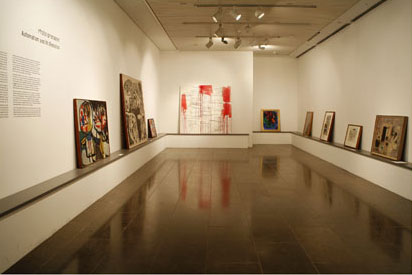
Aiming to rejuvenate poetry and the visual arts by drawing on untapped sources of creativity, Surrealism explored the mind’s hidden realms – dreams, mental illness, and the unconscious. Writers and artists developed “automatic” techniques in order to circumvent conscious control and access the wellspring of the unconscious. Automatism reflects the movement’s fascination with new developments in psychiatric thought in the late nineteenth and early twentieth centuries. Surrealists saw automatism as a visual parallel to Sigmund Freud’s use of free association in psychoanalysis.
According to André Breton, the essence of automatism consists of heeding the “voices…of our own unconscious,” while attempting to relinquish conscious control of logic, aesthetics, or morality – enemies of fantasy and creativity. The Surrealists strove to expand their mental worlds and recapture the freedom of imagination normally accessible only in childhood, in dreams, and perhaps in insanity. The role of reason was to be limited to recording and appreciating the magnificent phenomena produced by the unconscious.
Surrealism’s search for processes that would free artworks from conscious thought manifested itself in multiple forms and techniques. These include Jean Arp and André Masson’s “automatic drawings,” Paul Klee and Joan Miró’s semi-automatic works, Max Ernst’s frottages (rubbing) and grattages (scraping), and Oscar Dominguez’s decalcomania (blotting). Man Ray and other photographers developed techniques such as solarization, photograms, and chance effects to create mystery and ambiguity.
In the 1940s, with the wartime exile of major Surrealist artists to the United States, automatism became a major force for New York school artists. Future Abstract Expressionists, including Arshile Gorky, Robert Motherwell, Adolph Gottlieb, and Jackson Pollock, were impressed with the idea that the source of art could be the unconscious, and expanded the repertoire of automatism.
Biomorphism and Metamorphosis

Biomorphism reflects the tendency to favor ambiguous and organic shapes. Anatomy, plants, bodies of water, and astronomy inspire paintings, reliefs, and sculptures. Jean (Hans) Arp, Henry Moore, Yves Tanguy, and Raoul Ubac – each working in a distinctive style in the realm between figuration and abstraction – developed a language of “biomorphs.”
Arp simplified nature’s forms and reduced them to their abstract essence. His biomorphic works capture and express the vital energy of being, and liberate art from the constrictions imposed by civilization. Yves Tanguy’s paintings fuse animal, vegetable, and human figures with rock formations that hover in vaporous landscapes. During and after World War II, Tanguy’s landscapes became more deserted and war beaten, a convincing psychological portrait of wartime Europe.
Surrealism elevated magic and the transformational process of metamorphosis and hybridization. Picasso’s use of metamorphosis influenced Surrealism in the 1920s, and it appeared both as subject matter and as procedure in the figurative paintings of Leonora Carrington and in the more abstract, automatic works of André Masson.
Metamorphosis attested to the power of the individual imagination to transcend reality and reason in favor of the marvelous. American Indian and Oceanic cultures and their myths provided models of uncensored expression and images of human-plant metamorphosis. Drawing on non-Western cultures, alchemy, and other occult phenomena, Max Ernst felt that the artist must regain a mythic, spiritual harmony with nature lost in Christianity, Western rationalism, and technology.
Victor Brauner and Wilfredo Lam thrived on the occult and the mystical. Brauner’s art reflects a fusion of wide-ranging world cultures, mythologies, and religious beliefs. While focusing primarily on figuration – whether human, animal, or mythological – the works create an intricate lexicon of symbolic forms.
Desire: Muse and Abused
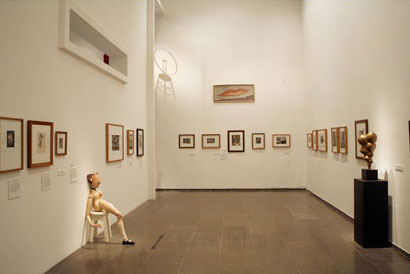
The exploration of desire offered artists and poets a vast territory in which to probe unconscious fantasies, fears, and inhibitions. The drive to liberate desire through art related to the rise of Communism and Fascism and to the two world wars. Libido became a revolutionary force, and constituted a rebellion against political and social censorship.
By the late 1920s, desire became a principal obsession. Sigmund Freud’s theories of sexuality circulated within the group, and artists and writers viewed themselves as agents of desire. Woman, perceived as a source of creative inspiration, offered promise and power. The passive femme-enfant (woman-child) was valued for her dual nature – naive yet seductive. The Surrealist conception of woman was patriarchal: “What matters is that we be masters of ourselves, the masters of women and of love too” (Manifesto of Surrealism, 1924). This elevation of desire was rooted in the ideas of eighteenth-century French aristocrat Marquis de Sade, who viewed uninhibited passion as a male right.
In paintings, objects, photographs, and collages the female body became a core component, either idealized and mystified or assaulted and fragmented – the passive target of violence. Collage and montage became supreme media through which to dissect, rearrange, or disfigure the female image. Using woman as an object for the projection of unresolved anxieties and conflicts, artists, particularly Hans Bellmer, examined the darker sides of desire.
André Breton viewed the physical reaction to art as indistinguishable from erotic pleasure. This intoxication reverberates in Man Ray’s photographs focusing on the female body. His legacy is evident in the work of Raoul Ubac, Manuel Alvarez Bravo, and Bill Brandt. Marcel Duchamp, with his female alter ego “Rrose Sélavy,” explores the erotic impulse and examines gender boundaries, recreating himself as an object of desire.
Illusion and Dreamscape
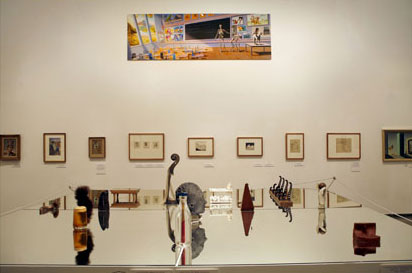
The belief in the intoxicating and liberating value of the imagination and the dream was central to Surrealism. Surrealist dreamscapes evoke mystery and challenge our perception of reality. They juxtapose disconnected objects, often within landscapes in which time and space are distorted. As in dreams, memory and place are disconnected and reality becomes fantastic. In the 1924 Manifesto of Surrealism, André Breton described a “resolution of these two states, dream and reality…into a kind of absolute reality, surreality.”
Dream imagery created by Surrealist artists reflects the influence of Sigmund Freud's groundbreaking Interpretation of Dreams (1900), where Freud described dreams as portals to the unconscious. The dream offered artists a territory in which judgment and reason are suspended.
Particularly influential in this context was Giorgio de Chirico, founder of the Italian movement of Metaphysical Painting. Captivated by the dark, elusive, and melancholic, de Chirico created timeless cityscapes that manipulate perspective and emanate an unsettling quality. René Magritte’s poetic inventions are seemingly simple images replete with complex associations. His visual metaphors reflect a mastery of the dramatic and the shocking. Both Magritte and Salvador Dalí exhibited unusual technical virtuosity; this allowed them to create tangible illusions that blur the border between reality and fantasy.
The fusion of images in an illusory space became popular in Surrealist photography as well. Photomontage combines multiple images in a single photograph. Using a medium usually perceived as most “real," Herbert Bayer challenged viewers by defying gravity and space. Bayer and others used eyes as recurring symbols of voyeurism and the power of inner vision. Dreams are perhaps best captured in cinema. Using montage, double exposure, and dissolve, Surrealist films evoke a hallucinatory state and equate the process of filmmaking with dreaming.
Marvelous Juxtapositions
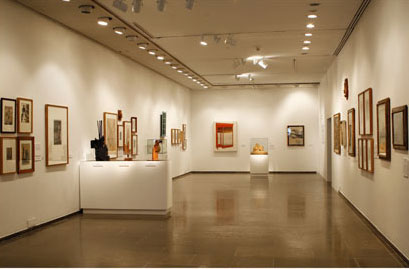
The use of found and readymade materials in Dada and Surrealist collages, montages, and objects break down the borders between art and life. Fragments of the everyday world placed in unexpected juxtapositions shock, seduce, and disorient the viewer. The relocation releases their poetic potential, creating a dream object “drawn from the strange depths of the unconscious mind.”
Dada exploited the rapid technological development of radio, cinema, manufacturing, and the illustrated press. The Dadaist were an international group, and included Kurt Schwitters, Hannah Höch, Max Ernst, Marcel Janco, Man Ray, and Marcel Duchamp, some of whom continued to be active in the Surrealist movement. Their strategies involved purchasing, editing, and arranging objects, texts, and mechanically produced images. Chance, humor, and punning were among their major weapons.
The readymade challenged handmade artifacts and the notion of self-expression. Exhibiting mundane items – a comb, bottlerack, or coat hanger – with almost no intervention, Dada artists questioned the transformation of an object when placed in a museum or gallery. The idea behind the artwork now constituted the real act of creation, anticipating late twentieth-century conceptual art. The Dadaists deliberately minimized the value of the original work of art and the artist’s effort and skill.
Duchamp’s radical operations began before the war and independently of Dada. André Breton described his readymades as precursors of the Surrealist object. These objects were perceived as visual equivalents of the powerful poetic metaphors used in Surrealist core texts: “beautiful as the chance encounter on a dissecting table of a sewing machine and an umbrella.”
Collages and objects inspired later artists, including Louise Nevelson, Joseph Cornell, and Christo, and have become mainstream activities in contemporary art, feeding into installation and site-specific works as well as commercial media.
Dr. Adina Kamien
Website, text, and photos © The Israel Museum, Jerusalem, 1995 - 2017
All rights reserved.
Works of art included in this website may be protected by copyright. Copyright in the individual works of art may be held by the artist, or the artist's heirs or agents. These works may not be copied, reproduced, or distributed without the copyright holder's permission.
For licensing of images and other copyright enquiries, please contact the Image Resources & Copyright Management Department.

